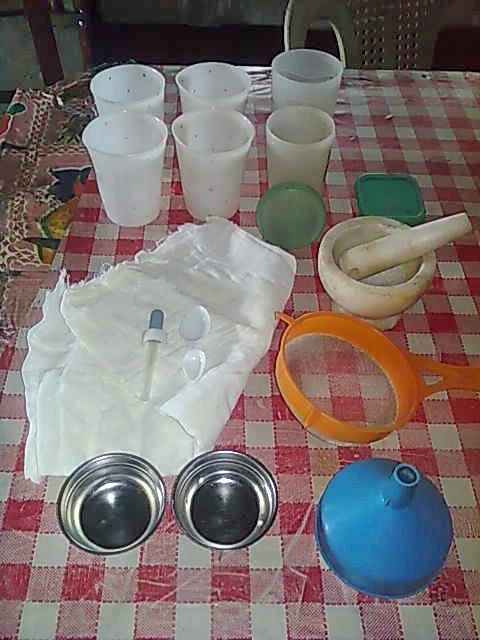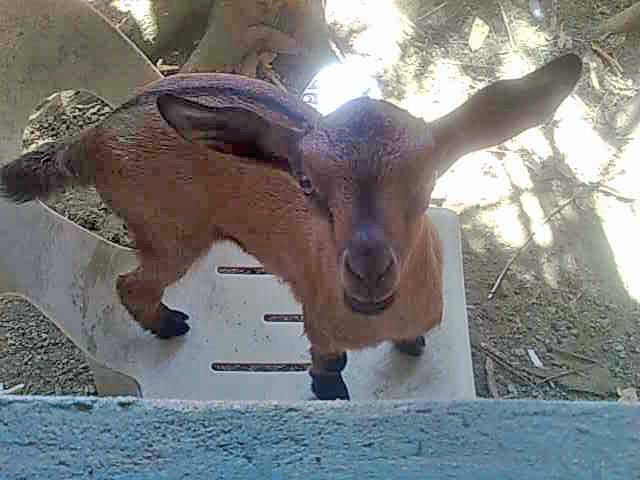Recently, we were happy to receive pictures and lots of information about making cheese in the province of Iloilo, Philippines from a courageous woman who is trying to help her inlaws make better use of their resources (goats). She is camera-shy, so we don’t have any pictures of her, but she did send some others along with her descriptions of the work she is doing.
 |
| Joan’s mother-in-law, Euginia |
 |
| Bada and Queenie |
One note about the cheeses she has been making-
Wara is a soft, white cheese, very similar to cottage cheese.
Woagochi is made the same way, but it is molded in a larger basket, soaked in a brine and colored in a solution made from the leaves and stems of red sorghum.
 |
| Ladling curds into molds |
Her story
Allow me to introduce myself. My name is Joan Parreno, a US citizen currently living with relatives here in central Philippines.
About 6 weeks ago, the island of Panay suffered a flood. The water level where I currently am reached nearly seven feet. Obviously, there was a lot of damage to the bamboo shanties, rice fields, and everything else. I am trying to help, and as I have experience with them, the instrument I’ve chosen is the goat.
The goats here seem to be mainly grade Spanish, and are raised exclusively for meat. When I proposed using a goat for milk, I was looked at like I was from Mars. They simply had no idea that a goat could do such a thing!
A few challenges:
Milking time
No hygienic vacuum driven milking machines here. Grab a teet and gently squeeze the milk into a cup. When you’ve got enough in your cup, transfer the milk to a covered container. When done
collecting, transfer the milk into a glass storage container by way of a filter (an old handkerchief), cover and refrigerate. I have a storage capacity of three 1-pint bottles and two 2-quart mayo jars.
 |
| Bong-bong and goat at the milkstand (aka stairs) |
 |
| The milking machine |
Cultures
Will have to be not only home-grown, but creatively obtained. Want rennet? Process some papaya leaves and experiment to see how much you need. Mesophilic Culture for more flavor? Buy some buttermilk (with live bacteria), or let the milk clabber and adjust for it’s relatively delicate curd. Mold Culture for more flavor? Buy a small piece of Roquefort or Camembert at the store in
the big city, and hijack the mold it’s carrying. But that’s a later experiment. Thermophilic/yoghurt culture? Same thing (with live bacteria) as with buttermilk.
 |
| The rest of the equipment |
Making rennet
Experiment #1
The following information was taken from Charles O’Conner’s Traditional Cheesemaking Manual.
I got the papaya leaves for the rennet on the 12th, and it’s now the 20th. So the liquid rennet has been in the refrigerator for 8 days. I don’t expect this to make too much difference, since it was refrigerated, but you never know.
The rennet was made according to the following recipe: Finely chop eight fresh, medium-sized papaya leaves, and soak in about 100ml (1/2 cup) of warm water. After about 5 minutes, strain the liquid. This is enough for 5 to 6 quarts of milk. I have produced half this amount because I was only brought four leaves instead of eight.
Note that I have read other references to papaya rennet that use half the amount, coagulation taking longer, but producing a generally superior product. I’ll try the reduced amount in a later experiment.
Note that papaya leaves contain a toxin, but the toxin appears to be destroyed at the temperature Wara is processed at, being raised to boiling after the rennet is added to the milk. I may try boiling the rennet itself for later experiments with other kinds of cheeses. But this might also destroy the coagulating quality.
Note that the original recipe called for 5-liters (quarts) of milk. But this experiment will be scaled for 1-liter (quart) due to my limited milk production of about 1-pint per day, which is a respectable quantity for a grade Spanish doe.
Note that the exact species of papaya is unknown. It is simply what grows locally.
Procedure:
1. Place 1 quart of milk over coals or smoldering fire and heat to about 120F (a little too hot for a bath), stirring gently. This should take about 30 minutes.
2. Add the papaya rennet and slowly heat the milk to just boiling. Boil milk until curds and whey separate. Stir gently to prevent burning the milk to the pan.
3. Remove from fire. Pour or ladle curds into baskets, and catch whey in a bowl for later use.
Note that Wara baskets look something like woven wicker chevre molds holding about 2 oz of cheese. Woagachi molds are larger, holding about 20 oz of cheese. I will be using Chevre molds because of my small quantity of milk, and because that’s all I have.
Note that this cheese is neither salted nor pressed. But it might make for an interesting experiment once the recipe is proved. It would likely improve shelf-life.
4. Once able to hold it’s shape,Wara cheese is placed in a cool bath to maintain freshness. Woagachi cheese is soaked in a 20% brine solution for 12-15 hours and then dipped in hot red sorghum leaf solution to color it. Both to be consumed or sold immediately.
The expected yield is 2-5 Wara Cheeses of about 2 ounces each, or a Baby Woagachi Cheese.
Results:
Temperature control was difficult due to the use of a wood fire for cooking. And not having a thermometer doesn’t help any. I thought I was going to end up with evaporated milk, but after about 20 minutes, the curds separated. I had enough goo for two Wara Cheeses, so one will be eaten right away, and one will be given a brine bath.
The drain holes in the molds plugged fairly quickly and needed to be cleared. The cat will appreciate the mess I left on the table.
An initial tasting of the curds gave a sweet milky flavor with a hint of papaya. Scent is similar. There is also a slight greenish tinge to the color. I can see why this cheese would be popular in the areas it comes from. It might also be saleable here, if it can be produced in sufficient quantity and a market for fresh cheese created. Most people around here think “Processed Cheesefood Product” is cheese. I also think a light salting, or just the brine bath of the Woagachi, would improve the flavor. The after-taste is pleasant and long lasting, but revealing a slight bitterness as the milk flavor fades away. A little salt in the cheese might help disguise the bitter.
It looks like I rushed the Woagachi cheese a little. I put it into the brine, and it dissolved. Disheartened, but not defeated, I ran the resultant soup through a cloth and reclaimed the curds which are now defacto salted. It will be left to drain for a while, and we’ll see what we’ve got. I’m not an experienced cheesemaker, maybe I didn’t cook it long enough. Oh yeah, I rushed it. The Wara is weeping whey in it’s dish. Well, not my fault. The instructions didn’t say how long anything would take. Ah, I’ve found something from another source that says it should have cooked for an additional 10 minutes after coagulation began, and not to just remove it from the fire. That’ll make a big difference. It also says it should be ready to go after 20 minutes in the mold. This could also explain the low yield. Gee, miss one little thing….
Now that I know the problem (or at least A problem), let’s try the stuff.
#1 – Undercooked Wara – Very wet, but sweet and tasty.
#2 – Curds salvaged from brine – Once I squeezed the brine out of it, it was bland curds, much like a Paneer. Just salty instead of sour.
Another potential problem: The wok we cooked the milk in is aluminum. But it’s all we’ve got. Double boiling I can do in stainless steel, but not direct cooking.
Conclusions:
The cheese has potential. Let’s correct the recipe and try that one again.
The papaya leaf rennet does seem to work. I’d rather use something that doesn’t have the potential to poison me, but it’s all I’ve got.
——
Experiment #2
Procedure:
1. Place 1 quart of milk over coals or smoldering fire and heat to about 120F (a little to hot for a bath), stirring gently. This should take about 30 minutes.
2. Add the papaya rennet and slowly heat the milk to just boiling. Boil milk until curds and whey separate, and continue to boil for an additional 10 minutes to promote separation of whey. Stir gently to prevent burning the milk to the pan.
3. Remove from fire. Pour or ladle curds into baskets, and catch whey in a bowl for later use.
4. After about 20 minutes, it should be able to hold it’s shape. Wara cheese is placed in a cool bath to maintain freshness. Woagachi cheese is soaked in a 20% brine solution for 12-15 hours and then dipped in a hot, red sorghum leaf solution to color it. Both to be consumed or sold immediately.
The expected yield is 2-5 Wara Cheeses of about 2 ounces each, or a Baby Woagachi Cheese.
 |
| Princess Joy holding Wara cheese, made with the first try |
To see Part 2 with Joan’s recipes for cooking with goat’s milk over an open fire, click here.















































































































































